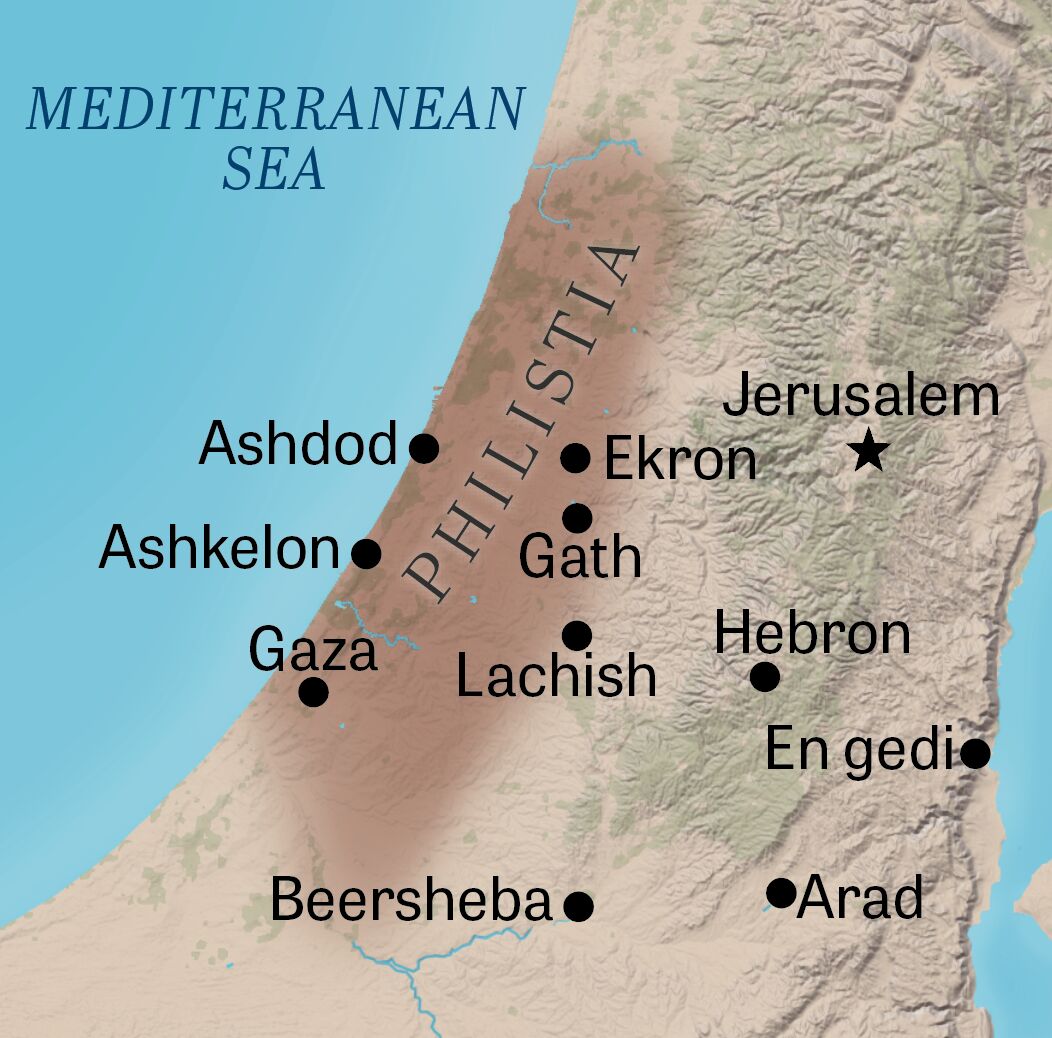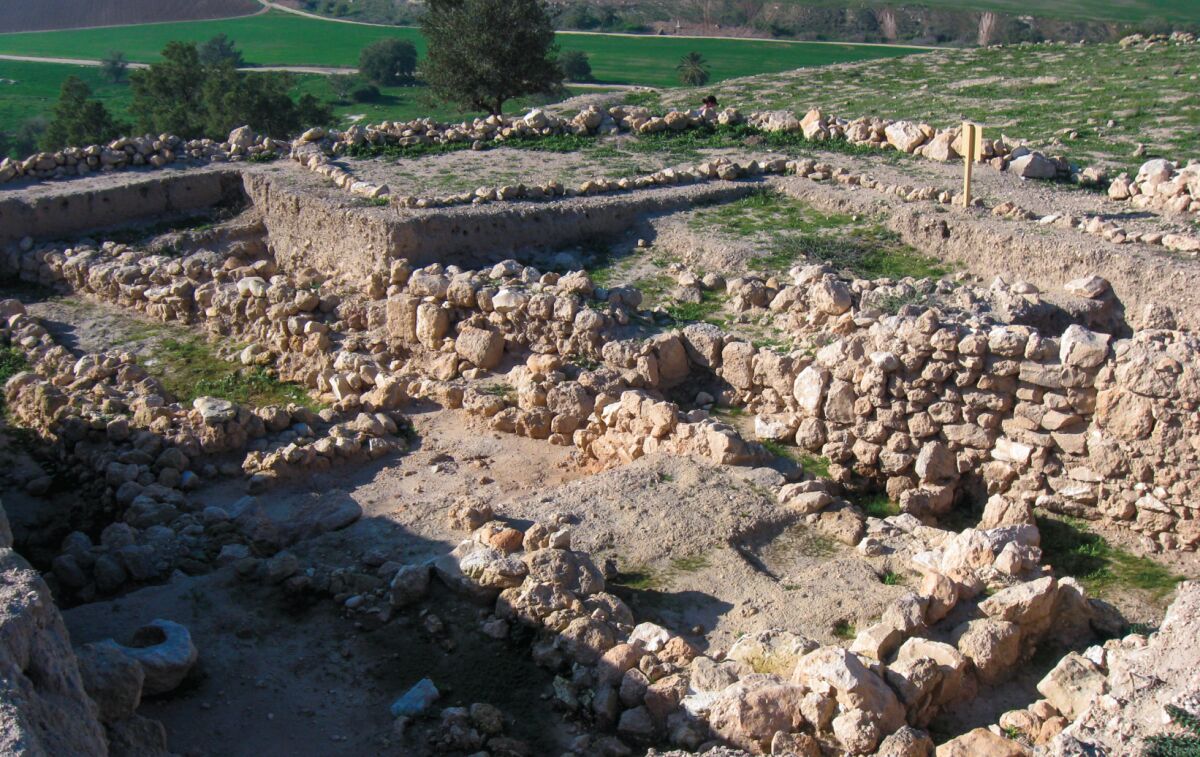Gath! The name is synonomous with an evil giant; though it means “winepress.” According to the Bible, 11th-century b.c.e. Gath was home to Philistine giants, including the infamous Goliath. It was also one of the major cities of the Philistine pentapolis, a confederation of five large city-states: Ashdod, Ashkelon, Ekron, Gath and Gaza.
The Philistines were Israel’s greatest adversary during the early Iron Age (the late judges period through the reign of King Saul and into David’s kingship). The Bible says that at this time Philistine garrisons controlled certain Israelite cities and were even powerful enough to prohibit Israel from sharpening their tools of iron. (1 Samuel 13:19-21 record that Israel had to pay the Philistines exorbitant prices for the service.)
This dynamic changed early in the reign of King David, when the kingdom of Israel, after a series of battles, broke free from the Philistine yoke and grew significantly more wealthy and powerful. Although defeated, the Philistines were apparently allowed to remain in their homeland (1 Chronicles 18:1).
The Philistines are often ignored or forgotten in the discussion about the archaeology of David and Israel. This is surprising considering the amount of archaeological evidence attesting to the presence of the Philistines in the 11th century b.c.e.—evidence that is in harmony with the biblical text.
In Has Archaeology Buried the Bible?, William Dever writes that “recent archaeological excavations … have illuminated Philistine culture …. All of the somewhat cryptic information concerning the Philistines in the Hebrew Bible has proven correct, even though they are portrayed as ‘the bad guys’ and are hardly the focus of the stories.”
While the Philistines might be relatively insignificant during the latter years of King David’s reign and through King Solomon’s, they are an important piece of the puzzle. If specific cities, events and practices recorded in the biblical text about the Philistines are consistent with what has been demonstrated archaeologically, this attests to the accuracy of the biblical text and certainly what it records about kings David and Solomon, both of whom ruled after the Philistine period of dominance.
In short: If the biblical text is accurate in what it records about the Philistines, isn’t it reasonable to accept that it is accurate in what it records about 10th-century b.c.e. Israel?
Who Were the Philistines?
The Philistine city-states were situated primarily on the coastal plain in the southwest Levant (their territory extended from the modern Egyptian border with Israel to southern Tel Aviv). Today it is accepted that the Philistines migrated into the region from the Aegean region (Greece), notably the island of Crete, around the 13th to 12th century b.c.e.
The Philistines’ origins have been confirmed by the dna sampling of human remains collected from an ancient cemetery in Ashkelon. Even before the dna testing confirmed Cretan origins, excavations at several Philistine cities revealed a material culture (pottery and other artifacts) remarkably similar to the Mycenaeans. The biblical prophets Amos and Jeremiah also relate that the Philistines of Saul and David’s era migrated from the Mediterranean and, more specifically, “the isle of Caphtor,” the ancient name for Crete (Jeremiah 47:4; Amos 9:7).
The timing of the Philistine migration matches perfectly with the biblical epoch in which they are featured—the latter part of the judges, when Samson, Samuel and Saul were on the scene. As the Philistines’ power increased, they expanded territorially. Several archaeological sites along the Yarkon River, in the heart of modern-day Tel Aviv, feature Philistine construction.
One of the most impressive Philistine sites is Tel Qasile (you can visit this site in downtown Tel Aviv). Coincidentally, Tel Qasile was the site that received the first exavation license in the modern State of Israel—and it was granted to Prof. Benjamin Mazar.
Built on virgin soil by the Philistines in the 12th century b.c.e., this ancient port city flourished until the time of King David. Tel Qasile is one of three Philistine sites with a unique temple design that features two central pillars erected within arm’s reach of one another, underscoring the biblical account of Samson’s death when he pushed over two foundational pillars of a Philistine temple.
During the time of King Saul, the Philistines’ sphere of influence extended east into the highlands, where they dominated Israelite settlements. 1 Samuel 10:5, 26 and 2 Samuel 23:14 show that the Philistines had garrisons at both Bethlehem and Gibeah.

Daniel Master—longtime excavator of Ashkelon, a prominent Philistine city—wrote in 2021 that “there was a moment in the 11th century b.c.e. when Philistia turned to the east [to the highlands of Israel]—not out of imperial ambition, but out of necessity because of broader Mediterranean patterns.”
This archaeologically based assessment matches the biblical account, which relates that throughout the reign of King Saul and into the reign of King David, the Philistines maintained the upper hand over Israel. The biblical text identifies the city of Gath as a key Philistine city. From Gath, which is situated close to Israelite territory, the Philistines were able to project power into Israel.
Excavating Gath
Gath is mentioned several times in the Bible, most famously in relation to events near the end of King Saul’s reign, when the Philistine giant Goliath taunted Israel’s terrified armies and was courageously confronted by David, who was just a youth. 1 Samuel 17 records that after David slew the giant, the Philistine army hastily retreated to nearby Gath (verse 52).
The city is mentioned again in 1 Samuel 21:13, where David—several years later but still in the late 11th century—escaped the wrath of Saul by seeking protection in Gath.
The original city of Gath has been identified with the modern-day site of Tell es-Safi. Situated in the western reaches of the Valley of Elah, the ancient mound of Gath rises 80 meters (263 feet) above the valley floor, giving it an elevated strategic position.
Like most ancient cities in the land of Israel, Tell es-Safi is a composite of numerous settlements built over centuries, each erected on top of the previous. For the longest time, excavations at Tell es-Safi mainly revealed a large biblical city constructed toward the end of the 10th century. Archaeologists dated the city to the time of Rehoboam, David’s grandson. This city apparently thrived for around 100 years until its destruction, most likely at the hands of the Aramean King Hazael (2 Kings 12:18).
But what about Gath from the time period of King David? Does it exist?
The Tell es-Safi expedition is led by archaeologist Prof. Aren Maeir, from Bar Ilan University. Maeir first began excavating Gath in 1996. It wasn’t until the summer of 2019, after 23 seasons of excavation, that Maeir and his team began to expose 11th-century b.c.e. Gath. The discovery occurred after Maeir opened a new excavation area a short distance from the top of the tell, on the southern bank of the Elah stream.
Maeir is not a biblical maximalist. In the debate over King David and the biblical record, he is probably right in the middle. Yet even he was surprised by the discoveries of the 2019 season. “Up until now we thought that the city from the Iron iia, the one that Hazael destroyed, was the largest and most important period in Gath,” Maeir said in 2019. “This year we got a different story.”
During the excavation, Maeir shared the discoveries of massive walls and datable pottery on his excavation blog. “It looks like the motif for the 2019 season at Tell es-Safi/Gath is: ‘The awakening giant’—the massive early Iron Age city of Gath begins to surface! This, I believe, will change a lot of what we know about southern Canaan in the early Iron Age.”

By the end of the excavation, Maeir and his team had revealed a significant amount of the Iron i city of Gath—and it was gigantic: walls measured more than 4 meters (13 feet) thick (the largest walls from later periods measured 2 to 2.5 meters wide); some stones measured 1 to 2 meters (3 to 6 feet) long. Maeir learned that these walls and structures made up a large fortification, perhaps even two massive gates.
Archaeologists also found hard kiln-fired mud bricks, rather than softer sun-dried bricks. Kiln-fired bricks are rarely found earlier than the Roman period. Using pottery associated with the fortification, Maeir’s team was able to date construction of the site solidly to the Iron i period.
“No comparably colossal structures are known in the rest of the Levant from this period—or even from the later incarnation of Philistine Gath,” Maeir related to Haaretz at the time. The fact that the fortification was found some distance from the top of the mound indicates that Iron i Gath had expanded to its maximum size during this period. According to Maeir, the city covered just over 120 acres—more than twice the area of most comparable cities in the Levant. The sheer size of the Iron i Gath toppled the prior assumption that Ekron was the major Philistine city of the era.
While there is plenty of excavation yet to be done at Tell es-Safi, enough archaeology has been conducted to clearly attest to the biblical description of 11th- to 10th-century b.c.e. Gath.
The Bible shows the prominence Gath had among the Philistine cities during the time of King Saul. While David was on the run, the Gittite king granted him and his men safe haven in Gath. When Saul heard that David had Gath’s protection, Saul “sought no more again for him” (1 Samuel 27:4). Evidently, Saul was unwilling to pick a fight with the Philistine juggernaut.
Prior to 2019, after 23 seasons of excavations, the Gath of King Saul and David’s era remained elusive. Yet more recent excavations at Tell es-Safi not only reveal 10th-century b.c.e. Gath, they are revealing a city that looks very much like the one described in the Bible.
Excavations at Tell es-Safi, along with ongoing excavations at other 11th-century Philistine sites, are providing one more piece of the King David puzzle. At the same time, the fact that it took 23 years of excavation at Tell es-Safi to do so exposes the limits of archaeological excavation to be the absolute judge of biblical accuracy.
Sidebar: 10th-Century Philistine Names Mirror Goliath
While the famed giant Goliath has not been attested to archaeologically, his name has. We have the evidence in the form of two names inscribed on a potsherd discovered at Tell es-Safi in 2005. The inscription, which dates to around the 10th century B.C.E., is the earliest alphabetic Philistine inscription ever discovered. The two names, Alwat and Wlt, provide a linguistic link to the name Goliath.
Our Anglicized version of “Goliath” is much different from the original—pronounced in Hebrew as Galyat. Additionally, the English transliteration of these three names does not clearly illustrate their similarities. These names all show Indo-European roots (rather than Semitic roots like the Canaanite and Hebrew names). The significance of these inscriptions is made clearer when considered in terms of their spelling:
גלית (Galyat)
אלות (Alwat)
ולת (Wlt)
The dating of the inscription is also significant. “Since the inscription dates to circa 950 b.c.e., it comes from almost the same period as the battle of David and Goliath according to the biblical chronology!” wrote Aren Maier on the Tell es-Safi excavation blog.
This confirms the distant Mediterranean origins of the Philistine peoples and lends support to the biblical accuracy of the story of Goliath—authentic in name.

